The Mississippi River is a major waterway in the US that winds down the middle of the country. With hundreds of tributaries that flow into the Mississippi, it is one of the largest waterway systems in the world. People count on the river for transporting goods, electric power, and fresh water. Wildlife depends on it as an integral part of the ecosystem, such as the migrating birds that use the Mississippi Flyway during their migrations.
The river spans 2,350 miles long but where is the narrowest point on the Mississippi River? Is it true that you can walk across the Mississippi River? Let’s find out!
Where is the Mississippi River?
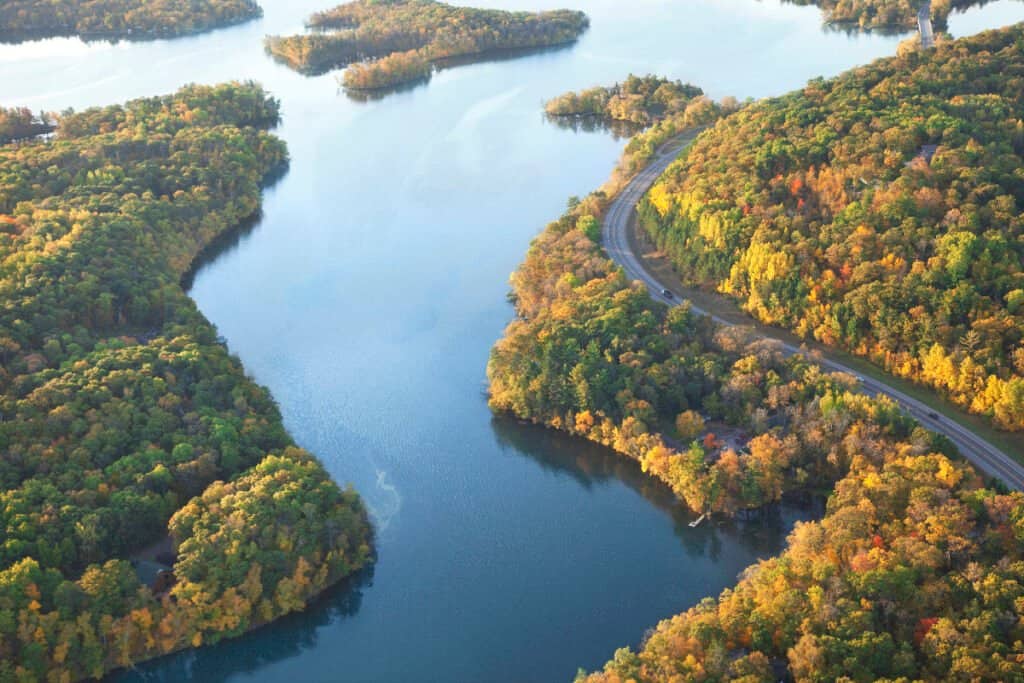
The Mississippi River flows from Minnesota down to Louisiana.
©iStock.com/Willard
The Mississippi starts in a small town in Minnesota. The headwaters start in Lake Itasca and then it flows down along the border of Wisconsin, Iowa, Illinois, Missouri, Kentucky, Tennessee, Arkansas, Mississippi, and Louisiana. Just past New Orleans, the river empties into the Gulf of Mexico.
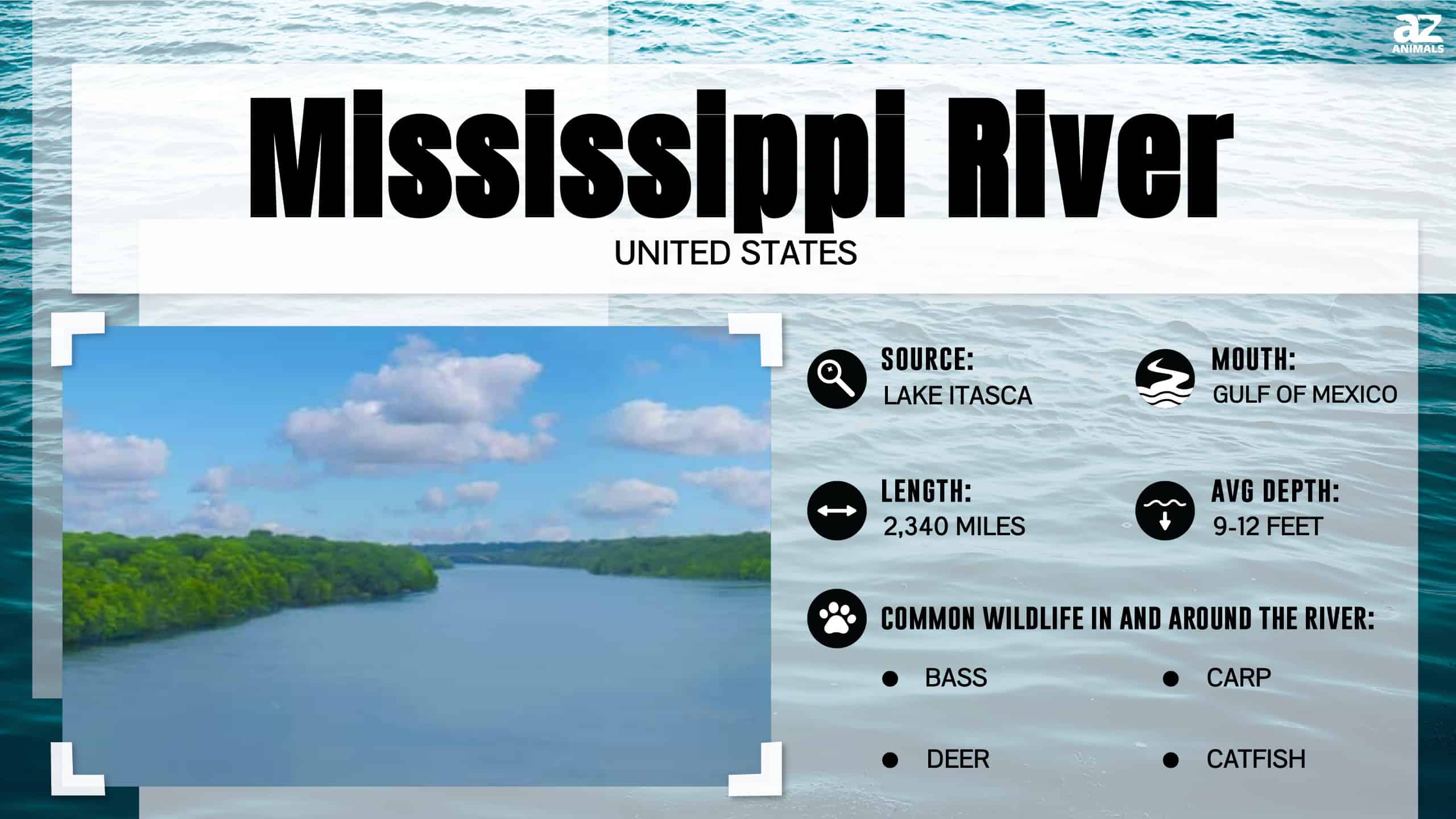
What Animals Live On the Mississippi?

The Mississippi River is one of the longest and most iconic rivers in North America.
©EyeTravel/Shutterstock.com
The Mississippi River is one of the longest and most iconic rivers in North America. Spanning over 2,300 miles, the river is home to a diverse range of plant and animal species. In this article section, we will focus on the animals that call the Mississippi River and its surrounding areas home.
Fish are the most abundant and diverse group of animals that live in the Mississippi River. The river is home to over 120 species of fish, including catfish, bass, and sturgeon.
The Mississippi River is also home to a wide range of amphibians and reptiles. Commonly found reptiles include snapping turtles, painted turtles, and alligator snapping turtles. In terms of amphibians, the river is home to a variety of frogs, including the American bullfrog, the green frog, and the northern leopard frog.
Birds are also commonly found in the Mississippi River basin. Some of the most commonly seen birds include the great blue heron, the belted kingfisher, and the bald eagle. These birds are often seen along the banks of the river, as well as in the surrounding wetlands and forests.
Finally, the Mississippi River is also home to a variety of mammals.
How Big is Lake Itasca Compared to the Gulf of Mexico?
Lake Itasca in Minnesota is a small 1.7 square miles (4.4 square km) lake that flows down to the Gulf of Mexico which is 617,800 square miles (1.6 million km2)!
What is the Narrowest Point on the Mississippi?
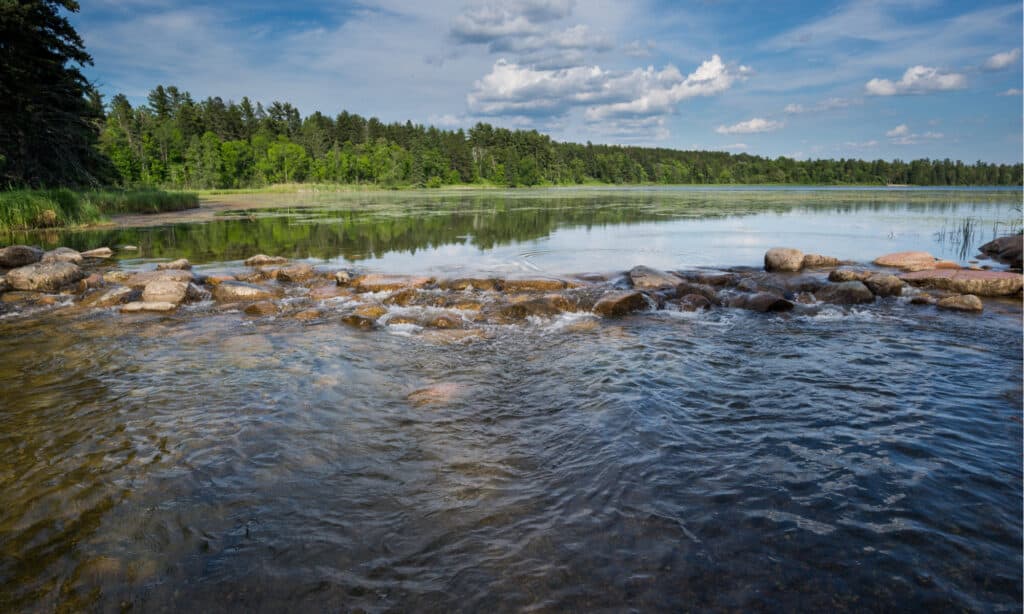
The narrowest point on the Mississippi River is at Lake Itasca, the headwaters.
©Tomaz Kunst/Shutterstock.com
On the Mississippi River, the narrowest point is at its headwaters in Lake Itasca, Minnesota. At the narrowest point, it is 20-30 feet wide. For reference, an average living room is 16 x 20 feet wide. Walking from one end of your living room to the other is about how narrow the Mississippi gets!
Can You Walk Across the Mississippi River?
Yes! Lake Itasca is a tourist attraction because you can slip your shoes and socks off and wade across the river. You can also walk across the boulders that separate the river from the lake or take the log walking bridge. Something to brag about!
What is the Headwaters Monument?
The Headwaters Monument is a tall tree stump that has a carved message that states: “Here 1475 feet above the ocean, the mighty Mississippi begins to flow on its winding way 2552 miles to the Gulf of Mexico.” After you walk across the Mississippi (and back!) this is a favorite place to take a photo to commemorate your visit.
Is Lake Itasca State Park the Oldest State Park in Minnesota?
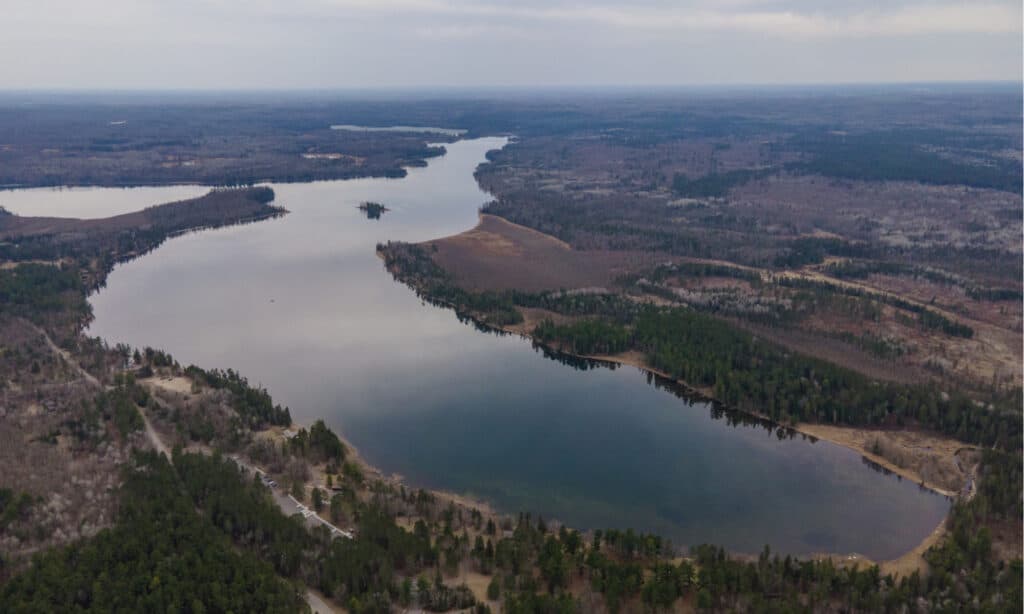
Lake Itasca State Park is the oldest state park in Minnesota, established in 1891.
©WhiteFieldPhoto/Shutterstock.com
Yes! The state park was established in 1891 to preserve the virgin pine forests and all the wildlife and plants that call it home. You can find classic animals like squirrels, chipmunks, rabbits, and white-tail deer as well as less common animals like black bears or wolves.
The NBA men’s basketball team in Minnesota is called the Timberwolves due to the few remaining timber wolf populations in the US. Lake Itasca State Park has a sandy swimming beach, miles of trails, and a large campground.
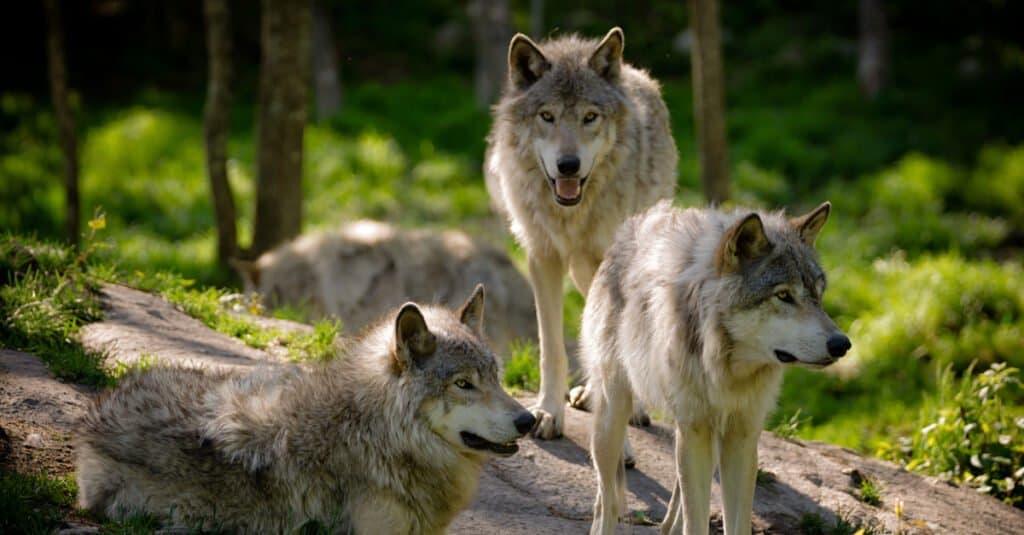
Look at these amazing Timberwolves! They live in northern Minnesota including areas in Itasca State Park.
©iStock.com/GatorDawg
Where is the Widest Point on the Mississippi River?
The widest point on the Mississippi River is 11 miles wide at Lake Winnibigoshish near Bena, Minnesota. Lake “Winnie” as they call it is in central Minnesota about 30 miles NW of Grand Rapids. The Mississippi River enters the lake on the western shore and travels eastward exiting on the other side where it finally turns south toward Grand Rapids. It follows the contour of the earth from Grand Rapids to Brainerd, St. Cloud, and then on to Minneapolis. From Minneapolis, it continues its trek all the way down to New Orleans, Louisiana, and the Gulf.
Five Facts About the Mississippi River
The Mississippi River is one of the most iconic waterways in the United States, stretching for over 2,300 miles from Minnesota to the Gulf of Mexico.
Here are five interesting facts about this famous river:
- It is the second-longest river in North America. The Mississippi River is the second-longest river in North America, after the Missouri River, which is its primary tributary. Together, the two rivers form the largest river system in North America and the fourth-largest in the world.
- It has a rich history. The Mississippi River has played an important role in the history of the United States. It was a major transportation route for Native Americans, early explorers, and settlers, and it played a crucial role in the development of trade and commerce throughout the country.
- It is home to a diverse range of wildlife. The Mississippi River and its surrounding wetlands are home to a wide variety of plants and animals. Some of the most notable species include bald eagles, river otters, alligators, and various species of fish, including catfish, bass, and sturgeon.
- It has been the site of many significant events. The Mississippi River has been the site of many significant events throughout history, including the Battle of Vicksburg during the Civil War, the Great Flood of 1927, and the Deepwater Horizon oil spill in 2010.
- It is a major source of hydroelectric power. The Mississippi River is an important source of hydroelectric power, with numerous dams and power plants located along its length.
Finally, the Mississippi River is a fascinating and important waterway with a rich history and a diverse range of wildlife.
Can You Swim Across the Widest Point of the Mississippi River?
You certainly couldn’t walk across the widest point, but could you swim it? There don’t seem to be any record holders or anyone boasting about swimming across Lake Winnie, but an 11-mile swim by a trained long-distance swimmer averaging a 35-minute mile could make the trip in around 6-and-a-half hours.
In general, it is not advised to test fate by swimming in the Mississippi River due to the strong and unpredictable currents. Also, remember this is Minnesota we are talking about… think winter and freezing temps! Generally not advised.
How Wide Does the River Have to Be for Ships and Barges?
The Mississippi River is a major waterway used for shipping grain, petroleum, iron, steel, wood, paper, coffee, coal, and more.
So what does it take to keep the waterways open so that ships can get through? The U.S. Army Corps of Engineers has to keep a 9-foot shipping channel from Baton Rouge to Minneapolis.
South of Baton Rouge to the Head of Passes they must maintain a 45-foot channel for ocean-going vessels. According to the National Park Service, “In a measure of tonnage, the largest port district in the world is located along the Mississippi River delta in Louisiana.”
Where is the Narrowest Point on the Colorado River?

Some points along the Grand Canyon narrow to as little as 76 feet across.
©sumikophoto/Shutterstock.com
The Colorado River is 76 feet across at the narrowest point. This point is in the Grand Canyon and is called Granite Narrows. You can look up at the sheer canyon walls extending upward and maybe even see an eagle swooping down to pluck some trout out of the river.
Granite Narrows is also the deepest point in Colorado reaching a depth of 85 feet! The Colorado River system starts high in the Rocky Mountains in Colorado and flows SW down to Mexico and empties just shy of the Gulf of California.
How Does That Compare to the Narrowest Point on the Mississippi River?
If you were standing on the goal line of an American Football field you would have to walk to the 6.6-10 yard line (20-30 feet) to cross the Mississippi. To cross Colorado you would have to walk a little past the 25-yard line (76 feet). These are pretty narrow rivers!
Can You Walk Across the Colorado River at the Narrowest Point?
No. You can take a raft, kayak, or canoe through that area but the currents are strong and there is not a tourist area to walk, wade or swim across the river at Granite Narrows.
What is the Widest Point on the Colorado River?
The widest point on the Colorado River is 200 feet wide at Grand Junction, Colorado. When it passes through Lake Powell, the Lake is 25 miles wide.
However, Lake Powell’s water levels are the lowest they have been since the beginning of the lake due to a 22-year-long drought. This is affecting the fish, crustaceans, and waterfowl that depend on the river.
The Missouri River which feeds into the Mississippi is also experiencing drought conditions. When the water levels are down the rivers get narrower all along the course of the river. Conservationists are working with multiple agencies to keep the rivers flowing.
The photo featured at the top of this post is © RaksyBH/Shutterstock.com
Thank you for reading! Have some feedback for us? Contact the AZ Animals editorial team.






